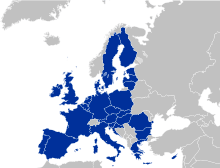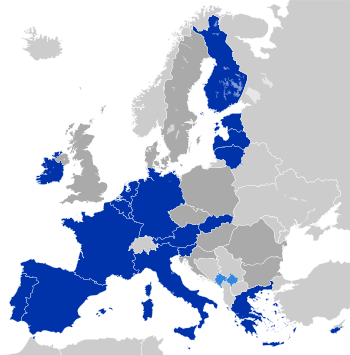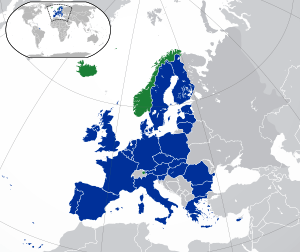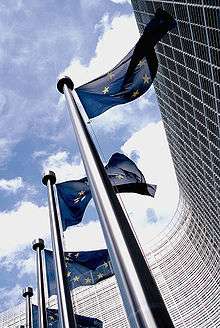Directorate-General for Migration and Home Affairs
The Directorate-General for Migration and Home Affairs (DG HOME) is a Directorate-General of the European Commission. The role of the body is to ensure the EU's security, to build a common EU migration and asylum policy, and to promote dialogue and cooperation with non-EU countries.[1] Thereby, it contributes to the Area of freedom, security and justice (AFSJ).
Structure
As well as a "shared resources" directorate (budget, human resources, etc.), the directorate-general has five functional directorates:
- Directorate A: Strategy and General Affairs
- Directorate B: Migration and Mobility
- Directorate C: Migration and Protection
- Directorate D: Security
- Directorate E: Migration and Security Funds.
Additionally, there are the following Migration and Home Affairs Agencies:
The current Director General of DG HOME is Matthias Ruete.[2] Relating European Commissioners are the European Commissioner for Migration, Home Affairs, and Citizenship and the European Commissioner for the Security Union.
Directorate A: Strategy and General Affairs
The Directorate Strategy and General Affairs is subdivided into (1) inter-institutional relations and citizenship, (2) legal affairs, (3) international coordination, and (4) knowledge hub for migration and security.
Directorate B: Migration and Mobility
The Directorate Migration and Mobility includes (1) legal migration and integration, (2) visa policy and document security, (3) information systems for borders and security, and (4) innovation and industry for security.
Directorate C: Migration and Protection
The Directorate Migration and Protection comprises (1) irregular migration and return policy, (2) border management and Schengen, (3) asylum, and (4) migration management support.
Directorate D: Security
The Directorate Security comprises (1) police cooperation and information exchange, (2) terrorism and radicalisation, (3) organised crime and drugs policy, and (4) cybercrime.[3] This includes the fight against terrorism and organised crime, by promoting police cooperation and by preparing to swiftly respond to emerging crises.[1]
Directorate E: Migration and Security Funds
This Directorate is made up of (1) union actions, (2) national programmes for South and East Europe; AMIF/ISF Committee, (3) national programmes for North and West Europe;Evaluations; MFF, and (4) budget and control.
In order to achieve its goals, the European Commission has released several agends. Current major agendas related to the DG HOME are the European Agenda on Security (2015)[4], the European Agenda on Migration (2015)[5], and the Cybersecurity Strategy for the European Union (2013)[6]. Other major agendas are the EU Global Strategy (2016)[7], the White Paper on the Future of Europe (2017)[8], the European Energy Security Strategy (2014).[9]
History
DG HOME was created in 2010 when the DG Justice, Freedom and Security was split into DG HOME and the Directorate-General for Justice.[10]
See also
- European Civil Service (i.a. for all DGs)
- European Commissioner for Migration, Home Affairs, and Citizenship
- European Commissioner for the Security Union
- European Commissioner for Justice, Fundamental Rights and Citizenship
- Directorate-General for Justice and Consumers
- Justice and Home Affairs Council (Council of the European Union)
- Area of freedom, security and justice
- Charter of Fundamental Rights of the European Union
- Four Freedoms
- European Convention on Human Rights
- Universal Declaration of Human Rights
- Police and Judicial Co-operation in Criminal Matters
References
- 1 2 "DG HOME: About us". 2017-10-13. Retrieved 2017-10-13.
- ↑ "DG HOME: Our Director General". 2017-10-13. Retrieved 2017-10-13.
- ↑ "DG HOME: Organisation Chart" (PDF). 2017-10-13. Retrieved 2017-10-13.
- ↑ "The European Agenda on Security" (PDF). 2015. Retrieved 2017-10-13.
- ↑ "European Agenda on Migration" (PDF). 2015. Retrieved 2017-10-13.
- ↑ "EU Cybersecurity plan to protect open internet and online freedom and opportunity - Cyber Security strategy and Proposal for a Directive". 2013. Retrieved 2017-10-13.
- ↑ "Shared Vision, Common Action: A Stronger Europe A Global Strategy for the European Union's Foreign And Security Policy" (PDF). 2016. Retrieved 2017-10-13.
- ↑ "The White Paper on the Future of Europe" (PDF). 2017. Retrieved 2017-10-13.
- ↑ "European Energy Security Strategy". 2014. Retrieved 2017-10-13.
- ↑ "Commission completes internal reshuffle". EurActiv. 3 June 2010.
External links
- DG Home Affairs
- Organisation Chart of DG Home
- The Commissioners - official homepage
- European Commissioner for Migration, Home Affairs, and Citizenship- official homepage
- European Commissioner for the Security Union - official homepage




